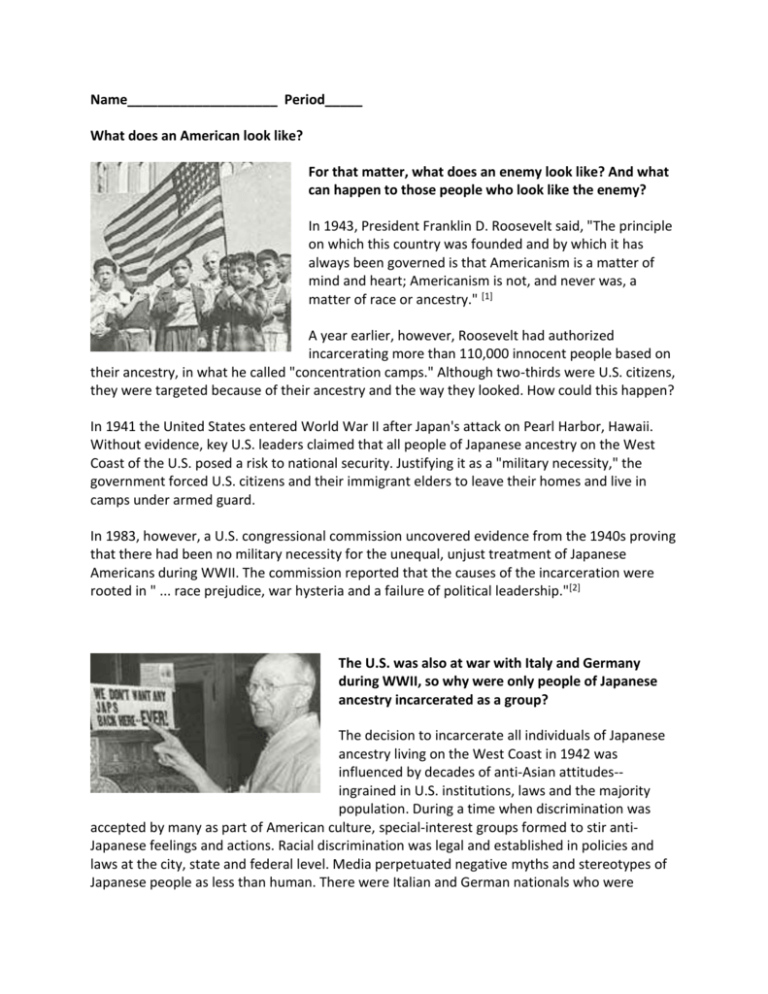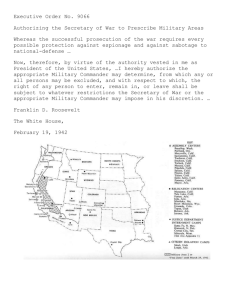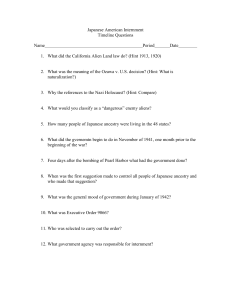Japanese Internment Causes Packet
advertisement

Name____________________ Period_____ What does an American look like? For that matter, what does an enemy look like? And what can happen to those people who look like the enemy? In 1943, President Franklin D. Roosevelt said, "The principle on which this country was founded and by which it has always been governed is that Americanism is a matter of mind and heart; Americanism is not, and never was, a matter of race or ancestry." [1] A year earlier, however, Roosevelt had authorized incarcerating more than 110,000 innocent people based on their ancestry, in what he called "concentration camps." Although two-thirds were U.S. citizens, they were targeted because of their ancestry and the way they looked. How could this happen? In 1941 the United States entered World War II after Japan's attack on Pearl Harbor, Hawaii. Without evidence, key U.S. leaders claimed that all people of Japanese ancestry on the West Coast of the U.S. posed a risk to national security. Justifying it as a "military necessity," the government forced U.S. citizens and their immigrant elders to leave their homes and live in camps under armed guard. In 1983, however, a U.S. congressional commission uncovered evidence from the 1940s proving that there had been no military necessity for the unequal, unjust treatment of Japanese Americans during WWII. The commission reported that the causes of the incarceration were rooted in " ... race prejudice, war hysteria and a failure of political leadership."[2] The U.S. was also at war with Italy and Germany during WWII, so why were only people of Japanese ancestry incarcerated as a group? The decision to incarcerate all individuals of Japanese ancestry living on the West Coast in 1942 was influenced by decades of anti-Asian attitudes-ingrained in U.S. institutions, laws and the majority population. During a time when discrimination was accepted by many as part of American culture, special-interest groups formed to stir antiJapanese feelings and actions. Racial discrimination was legal and established in policies and laws at the city, state and federal level. Media perpetuated negative myths and stereotypes of Japanese people as less than human. There were Italian and German nationals who were placed in internment camps such as Crystal City, Texas, but unlike Japanese Americans, U.S. citizens of Italian and German ancestry were not incarcerated during World War II. In what ways did our laws institutionalize racial prejudice against Japanese Americans? Until 1952, U.S. laws denied Japanese immigrants the right to become naturalized citizens. (Naturalization Act of 1790; Ozawa v. United States.) Forced to remain non-citizens, Japanese immigrants could not vote and had no voice or representation in U.S. democracy. States passed Alien Land Laws to prevent non-citizens from owning agricultural land and to restrict their ability to lease land. These laws were aimed directly at the Japanese: They were the only immigrants both ineligible for citizenship and largely dependent on farming for a living. Covenants against renting or selling homes to 'Orientals' were written into real estate contracts, anti-miscegenation laws barred marriage to Caucasians, and many children of Japanese ancestry attended segregated schools, even though most of them were U.S. citizens who had been born in the United States. As with African Americans and other people of color, the Japanese Americans were refused admittance to restaurants, theaters and other establishments. As Japanese American children grew up, many faced discrimination. Even with high grades, a college or professional degree, they were often denied access to certain professions, unions and apprenticeship systems due to the discrimination that was legally permitted at the time. Wartime Hysteria Virtually no one publicly questioned the rightness of the decision to incarcerate thousands of innocent families in the United States during World War II. Why did so few people speak out to defend our basic principles of "liberty and justice for all?" Many Americans reacted with fear and anger when the Japanese military attacked the U.S. Navy at Pearl Harbor on December 7, 1941. False reports of spying and sabotage by Japanese Americans and immigrants in Hawaii and on the West Coast combined with racial prejudice to inflame feelings of hate against all people of Japanese ancestry. Japan's military victories in Asia and reports in the news media intensified the crisis of war. "The Japanese in California should be under armed guard to the last man and woman right now and to hell with habeas corpus until the danger is over," wrote journalist Westbrook Pegler.[1] Key government leaders agreed with this view. They decided to imprison people without evidence or trials, denying their constitutional rights because of their ancestry. This policy was carried out on the West Coast of the United States, but not in Hawaii. 1. Personal Justice Denied, page 80 and citation in the notes: Westbrook Pegler, 'Fifth Column problem on the Pacific Coast very serious-Japs should be under guard,' Feb 16, 1942. What happens when fear-based thinking enters the decision-making process? In the attack on Pearl Harbor, more than 3,500 Americans were killed or wounded. "It is difficult forty years later to recreate the fear and uncertainty about the country's safety which was generally felt after Pearl Harbor; it is equally impossible to convey in a few pages the virulence and breadth of anti-Japanese feeling which erupted on the West Coast in January and February of 1942," stated the report of the Commission on Wartime Relocation and Internment of Civilians (CWRIC).[2] This antiJapanese feeling, anger and fear overwhelmed reasonable thinking. Many public officials made statements and called for actions that were not based on hard evidence, and which contradicted democratic principles. For example, then California Attorney General Earl Warren falsely claimed that Japanese Americans had "infiltrated themselves into every strategic spot in our coastal and valley counties" for spying and sabotage, and therefore they should all be removed from the West Coast. Warren had no real evidence, but offered as "proof" lists such as the following: Alameda County Japs adjacent to new Livermore Military Airport Japs adjacent to Southern Pacific and Western Pacific Railroads Japs in vicinity of Oakland Airport Japs in vicinity to Hold Caterpillar Tractor Co., San Leandro[3] A simple list of locations where some Japanese Americans lived and worked was not proof they were spies, but in the atmosphere of crisis and anger, many U.S. leaders and citizens felt Japanese Americans were guilty. In reality, the FBI, U.S. Naval Intelligence and other government sources reported no incidents of sabotage by Japanese Americans. Despite these reports, irrational arguments were made. "The very fact that no sabotage has taken place to date is a disturbing and confirming indication that such action will be taken," according to General DeWitt.[4] Failure of Leadership Certain principles and freedoms are guaranteed by our Constitution. Yet, without enforcement, the Constitution is just a piece of paper. Where does one turn if national leaders fail to uphold these fundamental rights? President Roosevelt ignored reports from Naval Intelligence, the FBI and other official sources that there was no need for either mass removal or incarceration of people of Japanese ancestry. According to then FBI Director J. Edgar Hoover, " ... the decision to evacuate was ... based primarily on public and political pressures rather than factual data."[1] Perhaps Roosevelt was influenced by anti-Japanese sentiments or misled by key advisors. Perhaps it was because there was no strong opposition to the incarceration on the West Coast. In any case, President Roosevelt encountered little resistance when he chose to violate the civil rights of a small, easily identifiable and politically powerless minority group rather than go against the rising tide of hostility. The U.S. Supreme Court upheld Roosevelt's decision. In sharp contrast to the mainland, the military leadership in Hawaii discouraged public hysteria and there was no mass incarceration on the islands. Economic Motives How did economics play a role in the decision to incarcerate thousands of innocent men, women and children? "We're charged with wanting to get rid of the Japs for selfish reasons and we might as well be honest. We do. It's a question of whether the white man lives on the Pacific Coast or the brown men," wrote Frank J. Taylor in the Saturday Evening Post.[1] Greed is a powerful motivator. The potential for economic gain was a major factor leading to the incarceration of people of Japanese ancestry. Groups that had competed with Japanese immigrant farmers and laborers for more than half a century lobbied for the incarceration. As with other minorities before them, people from Japan found that the United States' principles of equality were not applied to all, and rewards for hard work in the "land of opportunity" were often denied. Their hard work was often resented and successes on the West Coast were envied. In Hawaii, though, more than one-third of the population was of Japanese ancestry. They formed a major part of the labor force. Hawaii was the site of Japan's military attack on Pearl Harbor, and thus one might have expected an outcry there for the mass removal of people of Japanese ancestry. Different economic motivations were a factor in the prevention of such action. What were the causes of Japanese Incarceration in the Internment Camps? History of Racism – how was it a cause? Wartime Fears and Hysteria - how was it a cause? Failure of Leadership - how was it a cause? Economics - how was it a cause?







